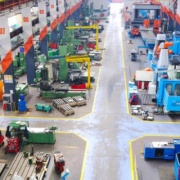Another Big Year Expected For Industrial Real Estate In 2022 — But Development May Be Stymied By Supply Chain
The U.S. industrial real estate market will continue to be on fire heading into 2022 but longer lead times to obtain construction materials and across-the-board price increases will also affect the sector.
Cushman & Wakefield PLC took a two-year look into the future, predicting industrial absorption from the start of 2022 to the end of 2023 will be 855 million square feet. Although demand will be high, and issues will make new industrial development challenging, Cushman expects new supply will slightly outpace demand in the next two years, which’ll help moderate the market somewhat.
Cushman is predicting new industrial deliveries will reach 932 million square feet in 2022 and 2023. E-commerce is a big reason — but not the only one — behind the warehouse sector’s massive growth since the pandemic. Online sales rose to 21.6% of total retail sales in the second quarter of 2020, compared to 16.2% in Q1 2020, and remain around 20% as of Q3 2021, according to CBRE Group Inc. (NYSE: CBRE) research.
“2021 was the best year ever for industrial real estate,” said James Breeze, senior director and global head of industrial and logistics research at CBRE, during a recent forecast call with reporters.
Third-party logistics have dominated industrial deal activity this year, a share that could grow in 2022 as costs continue to rise, and space and labor becomes more challenging to find.
“Many retailers or wholesalers will outsource their distribution to 3PLs at a greater clip in 2022,” Breeze said. “This outsourcing is going to be prevalent throughout the country.”
CBRE is forecasting vacancy rates next year for warehouses to remain at or even below 3.6% in 2022. Cushman is predicting industrial vacancy in North America will end 2023 at 4.1%. Expect rents to continue to rise for industrial occupiers, too. Cushman is forecasting average net asking rents for warehouse space in North America will reach a new high of $8.72 per square feet by the end of 2023.
“Even with the rental-rate hikes, tenants need warehouse space so much they’re willing to pay the new rates,” said Erik Foster, principal and head of industrial capital markets at Avison Young USA Inc.
“In fact, transportation costs are a bigger concern for many groups leasing warehouse space,” Breeze said.
Real estate costs are typically only 3% to 6% of total logistics costs, compared to 50% for transportation. The cost to ship goods via ocean freight grew more than 200% in 2021, while domestic-freight costs jumped more than 40%, according to CBRE.
“Leasing more space may actually save some occupiers money, if they are able to use additional facilities to cut down on domestic or international transportation,” Breeze added.
Investment activity for industrial real estate is expected to remain hot in 2022. Since the pandemic, some capital sources have pivoted away from uncertain asset classes, like retail and office, and instead poured money into industrial and multifamily, both of which have been on a tear in 2021.
Capitalization-rate compression across several U.S. markets has been observed in 2021 and is expected to continue, but cap-rate spreads between primary and secondary markets will be observed, CBRE predicts.
CBRE is predicting Phoenix and Las Vegas will post cap rates in line with the Inland Empire, about 3.1% in the first half of 2021, in 2022. Prices in the Pennsylvania Interstates 78/81 corridor are expected to be closer to those seen in New Jersey industrial markets, about 2.9% in H1 2021, says CBRE. Northern and central Florida could approach cap rates observed today in south Florida. Miami industrial real estate saw cap rates averaging 3.75% in H1 2021.
“With the amount of investor interest in industrial right now, there are some groups that don’t have much experience owning or operating warehouse real estate,” Foster said. “We’re seeing folks that are sophisticated, with real funds behind them, move in like never before to an asset class that they don’t know that well, which can cause risk.”
Source: SFBJ











